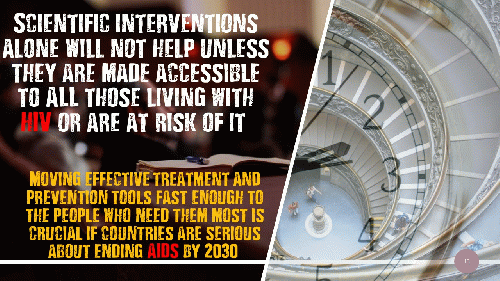
Scientific breakthroughs must translate fully into public health impact - and reach ALL those in need without any delay
(Image by CNS) Details DMCA
Recent scientific advances have brought to the fore the promise of more effective and long-term solutions to help people living with HIV to thrive and not just survive. Today we have a buffet of HIV-prevention options (such as, oral daily PrEP, once-a-month vaginal dapivirine ring for women, 2-monthly long-acting injectable) along with a bouquet of improved treatment modalities (monthly and 2-monthly long-acting injectables) adorning the HIV/AIDS arena, thanks to the untiring efforts of the scientific community. Many others are in the pipeline in different stages of research and development.
There is understandably a lot of excitement around these new products. But where are the recipients who have been waiting patiently for years to partake of this relatively lavish spread? Is it restricted to the favoured few residing in the global North or 'haves' in the global South? Do the majority of people who need these products have to stand in the waiting line indeterminately to access them? Are socio-economic, cultural, other structural barriers or social-commercial determinants impeding access of most-in-need people and communities to these new products and services?
Scientific interventions alone will not help unless they are made accessible to those living with HIV or are at risk of it. Moving effective treatment and prevention tools fast enough to the people who need them most is crucial if countries are serious about ending AIDS by 2030.
We know that it took a lot of time initially for antiretroviral therapy to become accessible and affordable for the people living with HIV, especially in the global South - thanks to the untiring community-led stewardship of global but grounds-up campaign to improve access to lifesaving medicines for all. But even in the present times, it seems that the nationality, race, and socioeconomic status of a person determine whether and when she/he/they will be able to receive the bounties of science. Even today 25% of people living with HIV are not on treatment and last year (2020), 690,000 people died from AIDS-related illnesses and 1.5 million were newly infected with HIV, despite the best tools that science has doled out. Readers, this is the concluding article in the series of an exclusive trilogy authored by CNS head and IAS HIV Science 2021 Media Fellowship Awardee Shobha Shukla.
Oral PrEP (Pre-Exposure Prophylaxis), the first biomedical intervention for prevention of HIV, was approved by US FDA for adults in 2012. But as per latest data of AVAC's Global PrEP Tracker only 1.3 million people globally have been initiated on it (as against UNAIDS target of reaching 3 million by now) and that too mostly through implementation and demonstration projects. PrEP is available at the national level in the public sector mostly in countries of the global North, with the exception of Thailand and Uganda in the global South, and is still not affordable in many low- and middle-income countries. The lessons learnt in the delayed and fractured roll out of PrEP should not go waste but soften the ground for the launch of future products.
European Medicines Agency (EMA), US FDA and Health Canada have already approved the 2-monthly long-acting Cabotegravir/Rilpivirine injection for treatment. But it is anybody's guess when it will be approved in other countries. Moreover, Rilpivirine, requiring a cold chain, would make it more difficult for low- and middle-income countries to include it in their national health system.
EMA and the World Health Organization (WHO) recently approved the dapivirine ring for use as an additional HIV-prevention choice for women in high-burden settings. Zimbabwe is the only country in the global South that has been quick to approve this female-initiated long-acting prevention product. However, dossiers of the ring have been submitted to national regulatory authorities of 7-8 other African nations, informs Dr Zeda Rosenberg, founder CEO of International Partnership for Microbicides (IPM), which has developed the ring. But it would still be quite some time before it reaches the hands of women who need it most. And the process for seeking its regulation in southeast and south Asian countries is yet to begin.
Also, let us not forget that Dolutegravir was approved for use by adult people living with HIV in 2013 and quickly became one of the most widely prescribed treatments for HIV in most high-income countries. But it took another 4 years to roll out its generic, affordable version in Africa in 2017. Likewise, in June 2020 US FDA approved a dispersible and flavoured paediatric formulation of Dolutegravir for use in infants and children. But till now only few countries, like Uganda, have been quick enough to roll out its generic formulation.
(Note: You can view every article as one long page if you sign up as an Advocate Member, or higher).





